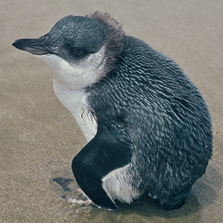Ruffling Feathers at Middle Island – The Annual Moult of the Middle Island Little Penguins Begins
In recent visits to Middle Island, the dedicated teams of volunteers, and Warrnambool Coastcare Landcare group members have observed another important milestone in the life cycle of the Little Penguin.
Roughly around the start of February, the Little Penguin adults begin their annual moult. This process allows the penguins to fully replace their suit of old and worn feathers with new plumage. Without a complete cover of structured and waterproof feathers, the penguins cannot survive at sea.
Little Penguins have highly specialised feathers, with a focus not on flight, but on a swimming mode of life. The contour feathers covering the little penguin’s body are short, rigid, and interwoven in multiple layers. Downy filaments at the base of the feathers trap air between them – much like a sleeping bag – to act as a very efficient insulator which keeps the penguins warm in the extremely cold temperatures they face at sea. The rigidity of the feathers helps the penguins to resist compression during diving and prevents the trapped air from being forced out, as well as reducing drag through the water, increasing swimming efficiency. The stiff, coarse filaments at the end of the feathers provide a waterproof seal that maintains insulation and assists with the penguin’s buoyancy. Waterproofing is assisted by secretions from an oil gland near the penguins’ tail, which is distributed during preening.
While the changes to a penguin during a moult appear subtle from afar, the transition from old feathers to new was quite apparent to the breeding survey team during observations of the penguin burrows over the last month:
- The first sign was the appearance of ‘static’ or ‘ruffled’ feathers on the penguin’s body. During their ‘pre-moult’ stage, new feathers begin to grow beneath the shafts of the old feathers, gradually pushing them out. The flippers of the Little Penguins appear swollen and warm to touch and the birds body may feel more ‘plump’. This is due to an increased blood supply in blood vessels close to the skin, provided to the growing feathers. Once the new feathers have almost reached their full length in 7-10 days, the old feathers start to fall out and the ‘moult’ stages officially begin.
- The second sign was an abnormally large number of penguin feathers in and around the burrow and box entrances. The little penguin has a large number of feathers to shed – with a density of approximately 12 feathers per square centimeter, a total of about 10,000 feathers!
- The third sign was the strange patterns of feather-shed on the penguins’ body. Little Penguins do not lose feathers uniformly. Because old feathers are lost through preening and abrasion, easy to get to areas like the back, and the front of the stomach lose their old feathers earlier. The exception is the flippers, which lose feathers before any other areas, as new feathers grow here before the rest of the body. About 12 days into the preening, birds will only have a last few patches of old feathers remaining on the top of the head and the neck. By about 17 days the penguin will have its full, new suit of stunningly bright and shiny dark feathers.
During this very important period of about 16 -17 days, the little penguins exert large amounts of energy, often losing up to half their initial body weight by the end of the moult. The little penguin’s ability to survive this hardship will depend heavily on their ability to gain sufficient pre-moult weight, spending prolonged periods at sea between the completion of raising their young and start of their moult. At this time, with some adults spending multiple days feeding at sea, and others bound to the shore while moulting, the monitoring team has been observing less birds coming ashore during arrival counts.
Having exhausted their fat-stores, the Little Penguins will spend the next few months recovering from the moult and spending a significant amount of time feeding at sea.



